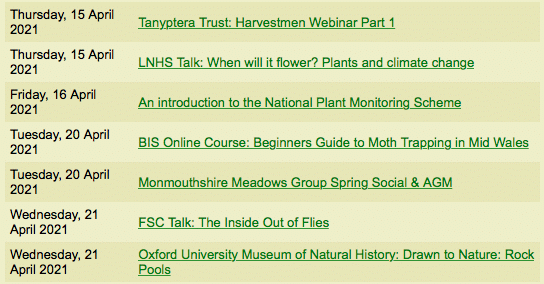By Eleni Foui, GiGL Partnership Officer (Planning)
“Local Environmental Records Centres (LERCs) are not-for-profit organisations that collect, collate and manage information on the natural environment for a defined geographic area. LERCs support and collaborate with a network of experts to ensure information is robust, and make information products and services accessible to a range of audiences including decision-makers, the public, and researchers.” www.alerc.org.uk
Even though LERCs are mostly associated with biodiversity data, they often provide services that are not strictly related to the data they hold and manage. Below are just a few examples of the wealth of non-data resources available through the records centre community.
South East Wales Biodiversity Records Centre (SEWBReC) have collated a list of online Home Based Wildlife Resources to support people that want to continue to monitor, and learn more about, biodiversity during lockdown restrictions. They provide a list of links to interesting online events, including those held by other records centres and natural history societies, as well as a huge range of YouTube courses to learn about different species groups. There are links to relevant newsletters and interesting podcast series.

The SEWBReC resource also provides a comprehensive list of wildlife surveys to get involved in at various times of the year, and a list of other home based activities, ranging from how to make a DIY butterfly net to inputting records on Zooniverse (GiGL have some 20th century bird observations you could help us input). There are also links to enjoyable webcams.
Other LERCs, such as Norfolk Biodiversity Information Service (NBIS), participate in European projects which promote the exchange of knowledge, skills, tools and approaches between partners. For example, the BID-REX project From Biodiversity Data to Decisions aims to build regional development policies to enhance natural value by “creating/reinforcing the link between relevant biodiversity data and conservation decision-making processes”. Several resources have been produced, including examples of regional level action plans and technical documents.
GiGL, through the Biodiversity Evidence – Better Outcomes from Planning project, collated information from 23 London Local Planning Authorities (LPAs) in relation to how biodiversity is taken into account in the planning process. The aim of the project was to support planning authorities to achieve better outcomes for biodiversity. We organised a training event for LPA staff, with sessions on legislation and London focused policies, biodiversity data in the planning process, common triggers for further ecological investigation, ecology reports and wildlife crime. We also produced a suite of resources for planners and in-house ecologists. These were tailored by the inputs of the project’s participants but will be added to and kept up to date.
GiGL has also collated a list of planning documents for each London LPA and their contact details. The list includes Local Plans, associated policy maps and Biodiversity Action Plans. We believe that this compilation is a very useful, time-saving resource as sometimes these documents are hard to find.
We would be very interested to know if you have used any of these resources for your work or during your free time – or if you are planning to use them in the future. If you know of any other non-data resources that LERCs provide, please get in touch by adding a comment below.
